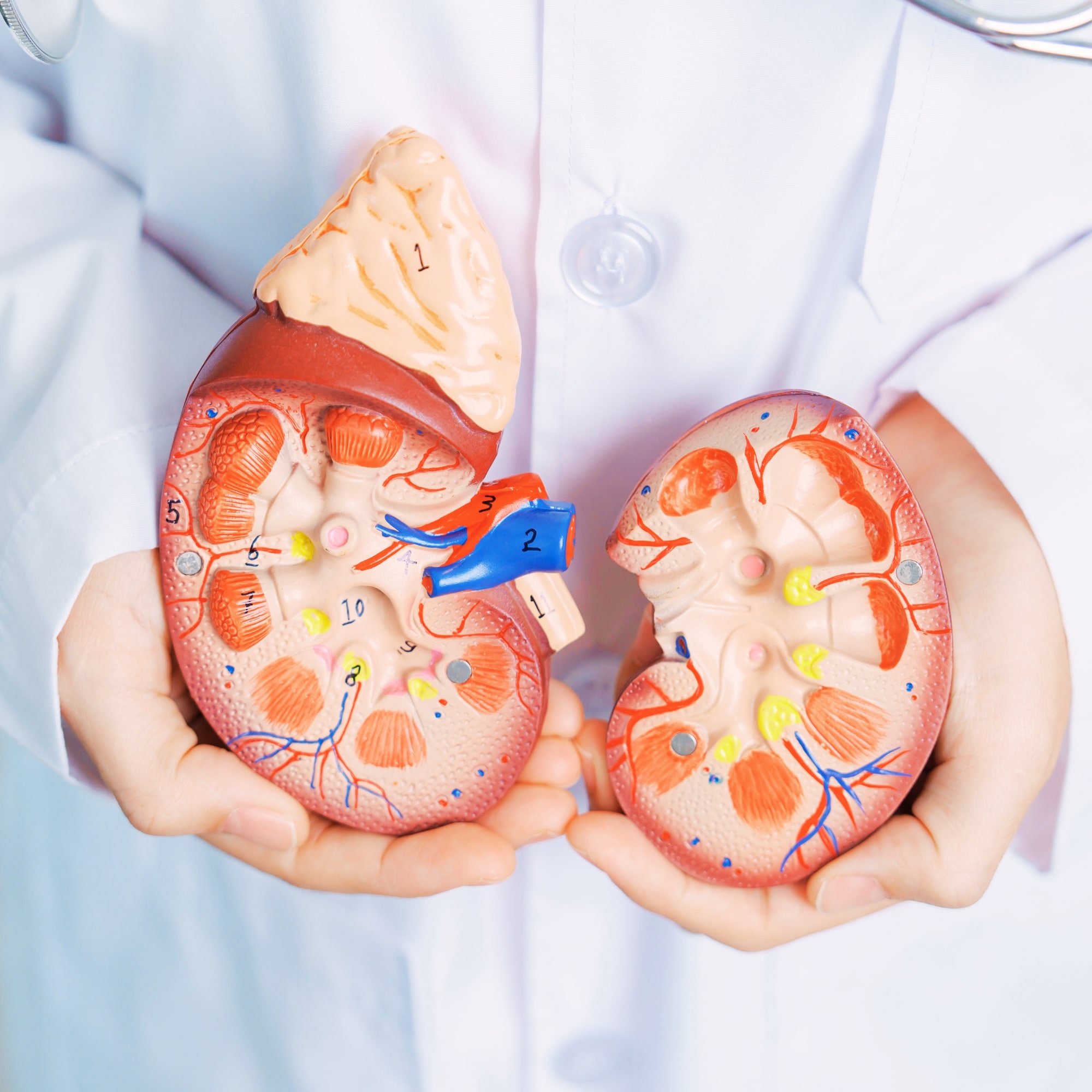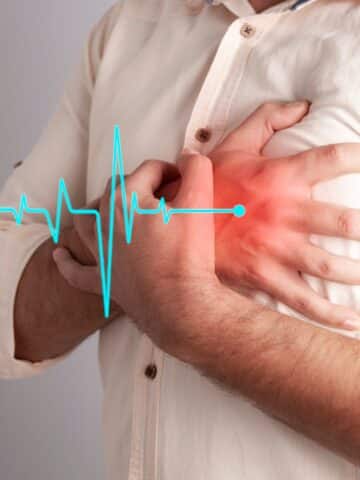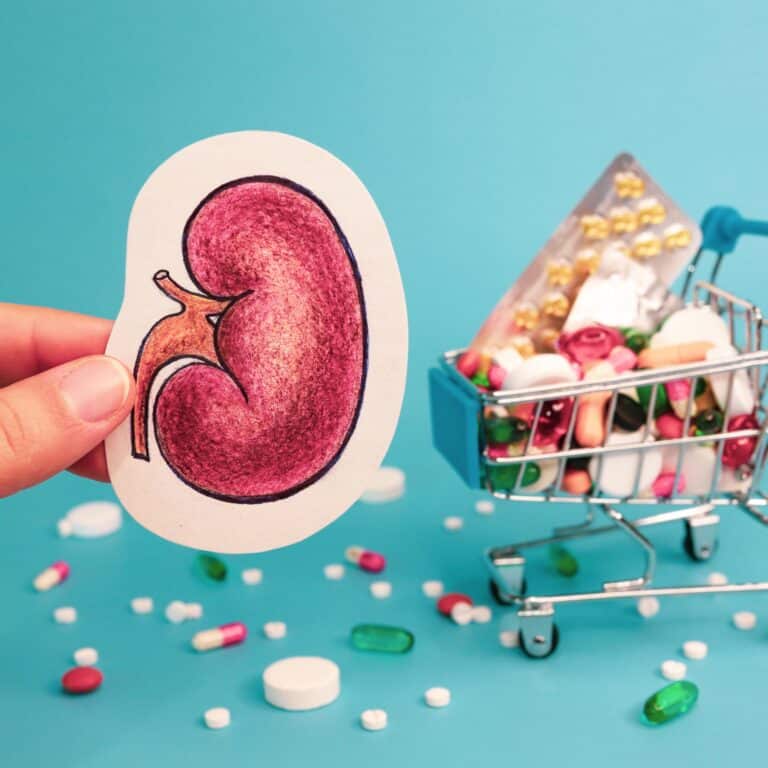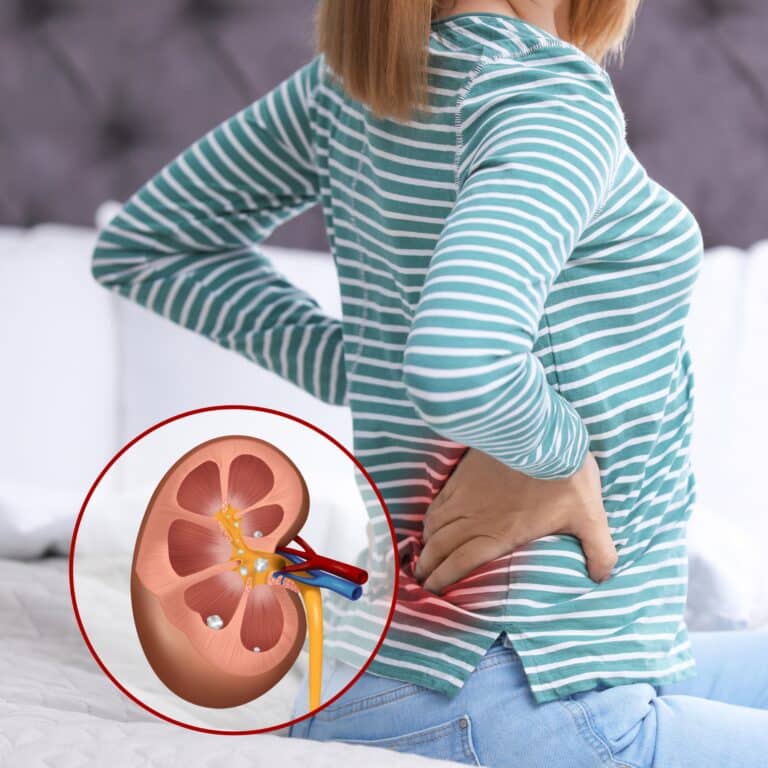Define End Stage Renal Disease
Through the stages of renal diseases, you have learned that chronic kidney disease means that you are losing function in your kidneys. Once you reach the last stage of chronic kidney disease, you are in what is referred to as an end-stage renal disease (ESRD).
This final stage of kidney disease means that there is little to no kidney function left, and action needs to be taken to replace that function. Usually, this means dialysis or transplant.

Jump to:
Key Takeaways
- End-stage renal disease (ESRD) or end-stage kidney disease (ESKD) is the fifth and last stage of chronic kidney disease (CKD).
- ESRD occurs when the kidneys can no longer filter waste from the blood.
- Symptoms of ESRD include itchy skin, muscle cramps, nausea or vomiting, decreased appetite, swelling in the feet and ankles, abnormal urine appearance, difficulty breathing, trouble sleeping, and changes in urine output.
- Treatment options for ESRD include consulting a nephrologist, dialysis (machine-based blood cleaning), and kidney transplantation.
For More Recipes and Ideas --->> Get Your Free Meals and Recipes That Are Perfect for Pre-Dialysis Diets, Pre-Dialysis with Diabetes, or Dialysis Diets.
What Is Kidney Failure?
End-Stage Renal Disease (ESRD) signifies the most advanced stage of kidney dysfunction, where the kidneys no longer function adequately to sustain life without external interventions like dialysis or transplantation.
This section will delve into the comprehensive understanding of ESRD, exploring its diagnostic criteria, causes, symptoms, treatment modalities, and the profound impact it imposes on individuals' lives. Understanding ESRD is crucial for effective management and enhancing the quality of life for affected individuals.
Defining End Stage Renal Disease
End-Stage Renal Disease (ESRD) stands as the fifth and final stage in the progression of Chronic Kidney Disease (CKD), reflecting the most severe impairment of kidney function.
At this advanced stage, the kidneys' capability to filter waste products and regulate bodily fluids dramatically declines, necessitating renal replacement therapy (RRT) to maintain life. ESRD is characterized by a glomerular filtration rate (GFR) below 15 mL/min/1.73 m² or the requirement of kidney replacement therapy, such as dialysis or transplantation, to sustain life.
This stage signifies a critical juncture where kidneys have reached a state of permanent kidney failure, underscoring the need for immediate and ongoing medical intervention to manage complications and sustain vital functions. ESRD profoundly impacts an individual's health and necessitates comprehensive and often lifelong management strategies to support overall well-being.
Managing Disease Progression
Managing disease progression in Chronic Kidney Disease (CKD) involves multifaceted approaches aimed at slowing kidney deterioration and preventing advancement to End-Stage Renal Disease (ESRD).
Lifestyle modifications like dietary changes (limiting salt, phosphorus, and potassium), blood pressure control, and maintaining a healthy weight are pivotal. Tight management of underlying conditions like diabetes and hypertension also aids in preserving kidney function. Medications such as ACE inhibitors or ARBs help regulate blood pressure and mitigate proteinuria, delaying kidney decline.
Regular check-ups monitoring kidney function and timely intervention play a crucial role. Engaging with healthcare providers for tailored interventions, adhering to prescribed medications, and adopting a proactive approach in managing CKD significantly contribute to slowing disease progression and reducing the risk of reaching ESRD.

Recognizing Symptoms
As you monitor your kidney health, it's critical to recognize the early signs of end-stage renal disease (ESRD), such as persistent nausea, decreased urine output, and severe swelling in your extremities.
Assessing symptom severity can be indicative of the progression to ESRD, requiring immediate medical evaluation.
Your healthcare provider will use evidence-based guidelines to determine the extent of kidney damage and appropriate interventions.
Identifying Early Signs
Early signs of End-Stage Renal Disease (ESRD) may include symptoms like persistent fatigue, decreased urine output, increased need to urinate during the night, swelling in the extremities or around the eyes, unexplained weight loss, and difficulty concentrating.
As ESRD progresses, symptoms become more pronounced, including severe fatigue, nausea, vomiting, persistent itching, muscle cramps, and changes in mental acuity. Additionally, individuals might notice shortness of breath, chest pain, and high blood pressure. These signs indicate a significant decline in kidney function, resulting in the accumulation of waste products and fluids in the body.
Recognizing these symptoms early prompts timely medical intervention, helping manage complications and potentially slowing disease progression through appropriate interventions like dialysis or transplantation. Regular monitoring and awareness of these signs are crucial for individuals with kidney disease to seek prompt medical attention.
Symptom Severity Assessment
Recognizing the severity of your symptoms is crucial when dealing with the progression of chronic kidney disease toward end-stage renal disease. Assessing severity helps in symptom management, guides treatment options, and minimizes lifestyle impact. Early detection can alter the disease trajectory significantly.
| Symptom | Relevance to Severity Assessment |
| Edema | Indicates fluid retention; assess for heart or renal failure. |
| Urine Output | Decreases with advancing stages; measure for renal function. |
| Fatigue | Can signify anemia or toxin accumulation; evaluate for ESRD. |
| Electrolyte Imbalance | Potentially life-threatening; test to adjust treatment. |
| Hypertension | Common in kidney disease; control to delay progression. |
Early intervention based on these assessments can improve outcomes and enhance quality of life for those you serve.
Identifying Causes
You must understand that diabetes and hypertension are the leading causes of end-stage renal disease.
Your lifestyle choices, including smoking and excessive alcohol consumption, can significantly influence the progression of renal impairment.
A thorough assessment of these factors is crucial for early detection and management. By identifying and addressing these risk factors, healthcare professionals can potentially delay or prevent the onset of end-stage renal disease.
Common Disease Links
While you may not immediately link them, diseases such as diabetes and high blood pressure are the most common causes of end-stage renal disease. As a healthcare provider, you play a crucial role in understanding progression, conducting lifestyle impact assessments, and exploring treatment options tailored to each patient's needs. Nutritional intake impact is also vital, as certain dietary choices can exacerbate renal decline.
Here are key considerations:
- Diabetes: High glucose levels damage nephrons over time.
- Hypertension: Uncontrolled blood pressure can lead to nephrosclerosis.
- Glomerulonephritis: Inflammation of kidney filters often progresses to end stage renal failure.
- Polycystic Kidney Disease: Enlarged cysts disrupt kidney function.
- Lupus: Autoimmune attack on kidneys can result in irreversible damage.
Early intervention may slow disease progression, so it's imperative to recognize and address these common disease links.
Lifestyle Impact Assessment
Lifestyle plays a pivotal role in chronic kidney disease progression towards kidney failure. Unhealthy habits such as poor dietary choices (excessive salt, high protein intake), sedentary behavior, smoking, and excessive alcohol consumption can hasten kidney function decline.
High blood pressure and diabetes, often influenced by lifestyle factors, are primary causes of CKD. Managing these conditions through a healthy lifestyle—maintaining a balanced diet low in sodium, regular exercise, avoiding tobacco, moderating alcohol intake, and managing weight—can significantly slow CKD progression.
Lifestyle modifications also control blood sugar levels, reduce hypertension, and alleviate the kidneys' workload. These measures, along with medical management, help delay or prevent the advancement of CKD to kidney failure, highlighting the substantial impact of lifestyle on the course of the disease.
Diagnostic Methods
To assess kidney function and diagnose End Stage Renal Disease, your doctor will likely order an estimated Glomerular Filtration Rate (eGFR) blood test. This test calculates your level of kidney function and stage of kidney disease using your blood creatinine level, age, body size, and gender.
Additionally, comprehensive urine tests are conducted to detect abnormalities such as proteinuria or hematuria that can indicate kidney damage.
EGFR Blood Test
The estimated Glomerular Filtration Rate is a key indicator of kidney function calculated using a formula that considers creatinine levels, age, gender, and sometimes ethnicity. It measures the rate at which the kidneys filter waste from the blood.
In kidney failure, eGFR decreases significantly, indicating a substantial decline in kidney function. A lower eGFR signifies reduced filtration capacity and more advanced kidney damage.
Interpreting eGFR values helps classify the stages of chronic kidney disease, with values below 15 mL/min/1.73m² indicating kidney failure or end-stage renal disease. As eGFR decreases, the need for interventions like dialysis or transplantation becomes more imminent.
Additionally, monitoring eGFR over time provides insights into disease progression and guides treatment decisions, helping healthcare providers assess the severity of kidney impairment and plan appropriate interventions to manage CKD or prevent further deterioration.
Urine Analysis Methods
After determining your kidney function with an eGFR blood test, another essential diagnostic tool is a urine analysis, which can reveal additional information about the health of your kidneys.
Urine analysis techniques include urine composition analysis, which assesses the concentration of various substances, providing insights into your body's metabolic state.
Urine sediment examination allows for the detection of cellular elements, crystals, and casts that indicate renal pathology.
Urine protein analysis quantifies protein levels, which, when elevated, may signal kidney damage.
Lastly, urine electrolyte analysis measures the balance of electrolytes, crucial for maintaining homeostasis.
Collectively, these methods are invaluable for diagnosing and managing end-stage renal disease, guiding clinicians in tailoring your treatment plan.
Exploring Treatment Options
When managing end-stage renal disease, you're faced with critical decisions regarding dialysis and potential kidney transplantation.
Dialysis, either hemodialysis or peritoneal, acts as a lifesaving bridge, but a transplant may offer a more durable solution, contingent upon donor availability and your eligibility.
Concurrently, you must navigate dietary restrictions to mitigate uremic toxin buildup and optimize your overall health status.
Dialysis Versus Transplant
Dialysis and transplantation are vital treatments for kidney failure or end-stage renal disease (ESRD). Dialysis substitutes kidney function by filtering waste and excess fluids from the blood.
Hemodialysis uses a machine to filter blood, while peritoneal dialysis occurs within the abdomen using a cleansing solution. Although life-sustaining, dialysis is time-consuming and requires regular sessions, impacting lifestyle.
Renal transplantation is the preferred treatment, offering a better quality of life and long-term survival compared to dialysis. It involves surgically implanting a healthy kidney from a living or deceased donor. Transplantation frees patients from regular dialysis sessions, restoring kidney function and improving quality of life.
However, it requires immunosuppressive medications to prevent rejection and has limitations due to organ availability. Both dialysis and transplantation necessitate strict medical adherence and ongoing care to ensure optimal outcomes for individuals with kidney failure.
Dietary Management Importance
You'll need to make specific dietary changes as part of your treatment plan to manage your end-stage renal disease effectively. Adherence to dietary restrictions is crucial to limit the intake of certain nutrients that your kidneys can no longer process adequately.
Through careful meal planning, you can ensure that your diet supports your health without overburdening your kidneys. Nutritional counseling with a registered dietitian specializing in renal diets is instrumental in creating a customized eating plan.
They'll guide you on fluid management to prevent fluid overload, which is essential since your kidneys have diminished ability to regulate fluid balance. Monitoring and adjusting your protein intake is also a key aspect of dietary management, as it helps to minimize the accumulation of waste products while preserving nutritional status.
Dialysis Explained
As you face end-stage renal disease, understanding your dialysis options is crucial.
Hemodialysis typically requires visiting a clinic several times weekly, where a machine filters your blood through a vascular access.
Conversely, peritoneal dialysis offers you the flexibility to perform treatments at home by instilling dialysate into your peritoneal cavity to absorb waste, which is then drained.
Dialysis Types Compared
Hemodialysis and peritoneal dialysis are two primary forms of renal replacement therapy for kidney failure. Hemodialysis uses a machine called a dialyzer to filter blood, typically performed at a medical facility, usually thrice weekly. It involves accessing the bloodstream through an arteriovenous fistula, graft, or catheter.
Peritoneal dialysis occurs within the abdomen, using the peritoneal membrane to filter blood through a cleansing solution. This type can be done at home, offering more flexibility but requires daily exchanges of the solution.
Hemodialysis provides efficient and rapid waste removal but demands regular sessions and may lead to fluctuations in blood pressure. Peritoneal dialysis offers more independence but requires strict adherence to daily routines and carries a risk of infection.
Both have pros and cons, and the choice often depends on patient preference, lifestyle, medical condition, and access to resources and support.
Home Treatment Feasibility
Exploring your options, home dialysis provides a level of independence that can be pivotal in managing your end-stage renal disease effectively. Engaging in self-care options, such as peritoneal dialysis, offers home treatment benefits that include a flexible schedule and a familiar environment, reducing stress and potentially improving outcomes.
| Aspect | Home Dialysis | In-Clinic Dialysis |
| Environment | Home comfort | Medical setting |
| Flexibility | Custom schedule | Fixed times |
| Caregiver Support | Family involvement | Medical staff |
| Lifestyle Adjustments | Easier integration | More challenging |
| Remote Monitoring | Feasibility | Dependent on clinic |
Remote monitoring feasibility allows healthcare professionals to support your treatment from a distance. Lifestyle adjustments are more seamlessly incorporated into daily routines, ensuring continuity of care with significant caregiver support.

Importance of Diet Management
You must understand that managing your diet is critical in controlling the progression and symptoms of end-stage renal disease. Adhering to dietary modifications can significantly impact your electrolyte balance, fluid retention, and overall nutritional status.
Tailored nutritional intake, guided by a renal dietitian, helps mitigate uremic toxin buildup and can improve your response to treatments like dialysis.
Dietary Modifications Necessity
In end-stage renal disease, especially for those on dialysis, dietary modifications are vital to manage symptoms, prevent complications, and support overall health. The dialysis diet aims to regulate nutrient intake, primarily controlling sodium, potassium, phosphorus, and fluid intake.
Restricting sodium helps manage fluid balance and blood pressure, reducing the risk of coronary heart disease. Potassium regulation is crucial to prevent dangerous heart rhythm abnormalities. Phosphorus control is necessary to maintain bone health and prevent vascular calcification, common in ESRD.
Additionally, limiting fluids assists in maintaining proper fluid balance and avoiding complications like fluid overload and high blood pressure.
The dialysis diet is highly individualized and often requires the guidance of a renal dietitian to ensure that patients get adequate nutrition while adhering to these restrictions. Compliance with these dietary modifications is crucial to mitigate the risk of complications associated with kidney failure and dialysis.
Nutritional Intake Impact
Failure to regulate sodium, potassium, and phosphorus intake in a renal diet can lead to various complications in individuals with end-stage renal disease (ESRD) undergoing dialysis. Excessive intake of these nutrients can exacerbate existing health issues and provoke new complications.
| Nutrient | Complications |
| Sodium | Hypertension, fluid retention, edema, heart complications |
| Potassium | Arrhythmias, muscle weakness, heart issues |
| Phosphorus | Bone disorders, vascular calcification, heart complications |
High sodium intake can result in fluid retention, worsening hypertension, and potentially leading to edema and heart complications. Excessive potassium levels may trigger dangerous heart rhythm abnormalities and muscle weakness. Phosphorus overload can contribute to bone issues, vascular calcification, and further heart complications.
Managing these nutrients in a renal diet is essential to mitigate these complications. Adhering to recommended restrictions and working closely with healthcare professionals, particularly a renal dietitian, helps prevent these adverse effects, ensuring a balanced diet that supports kidney health and overall well-being in ESRD patients undergoing dialysis.
Frequently Asked Questions
End-Stage Renal Disease (ESRD) profoundly impacts mental health and cognitive function. It often leads to symptoms like depression, anxiety, and cognitive impairment due to factors like altered brain chemistry, side effects of treatments, and the stress of managing a chronic illness.
Patients may experience memory issues, difficulty concentrating, and emotional challenges, significantly affecting their overall quality of life and ability to cope with the demands of treatment and daily life.
Yes, End-Stage Renal Disease (ESRD) can trigger complications in various organs due to accumulated toxins and imbalanced fluid and electrolytes. Commonly affected organs include the heart, leading to cardiovascular disease like coronary heart disease, hypertension and heart failure. Additionally, the bones might weaken due to mineral imbalances, leading to renal osteodystrophy.
ESRD also impacts the blood, causing anemia, and can affect the lungs, causing pulmonary edema due to fluid retention. These complications often arise due to the systemic effects of kidney failure on multiple organ systems.
Managing End-Stage Renal Disease (ESRD) poses substantial financial burdens. Dialysis costs approximately $90,000 annually in the US, while kidney transplantation, although costlier initially (around $150,000), proves more cost-effective in the long run due to reduced ongoing expenses. However, these figures can vary based on insurance coverage, location, and individual medical needs.
Additional costs encompass medications, frequent medical visits, and potential post-transplant care. These expenses underscore the substantial economic impact of ESRD management, affecting both patients and healthcare systems.
You Can Still Successfully Manage Kidney Failure
Understanding kidney failure, also known as End-Stage Renal Disease (ESRD), is crucial for effective management. It represents the ultimate stage of kidney dysfunction where kidneys can't sustain life without interventions like dialysis or transplantation.
We have discussed its causes, symptoms, treatment, and impact. Early recognition of signs, lifestyle changes, and managing risk factors can help delay progression.
ESRD significantly affects mental health and other organs, leading to complications. The financial impact of managing ESRD is substantial, highlighting the need for comprehensive support systems.
The complexity of ESRD management underlines the necessity for holistic care and increased awareness to enhance patients' quality of life.













